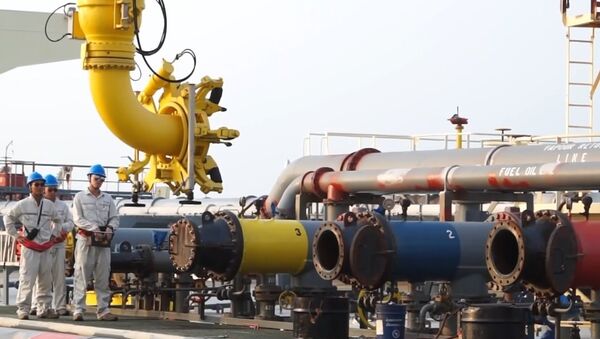It is no coincidence that the Rohingya-inhabited Rakhine State has repeatedly become the epicenter of social crises in Myanmar given the region's importance for China, Anthony Cartalucci, a Bangkok-based geopolitical researcher and author told Sputnik.
"The violence there is meant to disrupt China's projects and as it escalates, the possibility of Western agencies and even Western military assets being deployed increases," Cartalucci explained. "US military 'assistance' would effectively place the US military in a nation directly on China's borders and right in the middle of its ambitious One Belt, One Road project."
China's Twin Pipeline Project
In 2004, the first natural gas deposits were discovered offshore of Rakhine State immediately attracting China's attention. In 2008, Naypyidaw and Beijing signed an agreement to sell hydrocarbons to China via pipeline.
The logic behind the plan was understandable: the use of the land route decreased energy security risks.
Stratfor, also known as the "shadow CIA" reported in 2015 that Beijing wanted to "diversify [maritime] transit lines, thereby mitigating China's vulnerability to external economic disruption," highlighting that almost "82 percent of China's crude oil imports" passed through the Strait of Malacca in 2013.
"Passage through these maritime chokepoints is secured by another country: the United States, the world's dominant naval power," Stratfor noted, "US war planners have certainly not ignored China's geographic vulnerability… In the case of a war between the United States and China, many US strategists favor imposing a distant blockade of Chinese waters."
Since 2014, China's natural gas pipeline has been fully operational. However, the twin oil wasn't launched until April 2017.
Bumps in the Road of Sino-Burmese Relations
"Beijing's effort at currying favor with Aung San Suu Kyi and the NLD is borne partly of desperation and indicates how swiftly Beijing's stock in Myanmar is falling," Dhruva Jaishankar, a transatlantic fellow with the German Marshall Fund of the US, wrote for Foreign Policy magazine in 2015.
However, two years later, on August 12, 2017, The Diplomat admitted that "after a few rocky years, China is building up ties with Myanmar's new government" again.
"The reaction from the Naypyidaw is relatively positive, and the US retraction and economic downturn has created a window of opportunity for Beijing to engage," Amara Thiha of The Diplomat noted.

Myanmar's Hydrocarbons, China's Energy Security and the Rohingya Crisis
It appears that the latest Rohingya crisis that erupted in late August 2017, after the launch of the crude pipeline linking Myanmar's port of Kyaukphyu with the Chinese city of Kunming in Yunnan province, could have been artificially fanned.
"The Rohingya crisis is unfolding primarily in Rakhine State, precisely where China maintains a strategic port from which a variety of infrastructure projects including pipelines stretch," Cartalucci highlighted.
He surmised that "the violence is initiated by current head of state Aung San Suu Kyi's nationalist 'monk' supporters who also participated in the US-sponsored 2007 'Saffron' color revolution."
On the other hand, the early stages of the development of the Sino-Myanmar energy project also coincided with the intensification of the Rohingya conflict in 2011-2012 when 120,000 asylum seekers left the country escaping the bloodshed.
"There are other examples beyond Rakhine State where these nationalist "monks" are used to directly protest and attack Chinese infrastructure projects and business interests," the geopolitical researcher pointed out.
According to Cartalucci, "these protests and scuffles are coordinated, promoted by, and reported on by US State Department-funded fronts posing as nongovernmental organizations and media platforms that usually use 'environmental' concerns to couch what is essentially proxy destabilization aimed both at Myanmar's and China's economic future in the region."
'Violence Will Continue Along China's Peripheries'
The author suggested that it appears to be a combination of nationalist militias and gangs, factions within the military, and even foreign-funded militants involved.
According to the Bangkok-based analyst, "much of the violence carried out by Suu Kyi's supporters is not being mentioned at all in the Western media, with most of the blame being placed on the military."
He added that there are also reports of US-backed militants "posing as Rohingya who are attacking police and military units and provoking armed responses."
"The West thus is creating the violence with two opposing sides that it controls, and using the military and police's response to violent provocations as a means to undermine both institutions which have traditionally opposed and obstructed Suu Kyi's NLD from power, and US ambitions in the country in general," the author emphasized.
While all of Southeast Asia realizes the importance and benefits of building ties with Beijing, including those previously friendly with the United States, and the US has made it clear through its foreign policy and its actions on the ground that this will not be tolerated, Cartalucci pointed out.
"The violence will continue, not only in Myanmar, but anywhere along China's peripheries the US can create and sustain it," the geopolitical researcher predicted.
The views expressed in this article are solely those of the author and do not necessarily reflect the official position of Sputnik.





